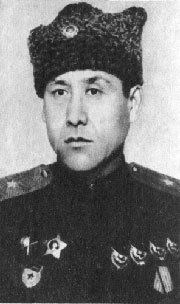Allegiance Soviet Union | Years of service 1922–1938, 1940–1945 | |
 | ||
Native name Sobir Umar o'g'li Rahimov Commands held 395th Rifle Division37th Guards Rifle Division Battles/wars Basmachi RebellionWorld War IIBattle of the CaucasusEast Pomeranian Offensive Awards Order of the Red Banner (4)Order of Suvorov 2nd classOrder of Kutuzov 2nd classOrder of the Red Star Battles and wars Basmachi movement, World War II, Battle of the Caucasus, East Pomeranian Offensive | ||
Sobir Umar o'g'li Rakhimov (25 January 1902 – 26 March 1945) was an Uzbek Red Army Major general and Hero of the Soviet Union. Rahimov fought in World War II and commanded the 37th Guards Rifle Division from November 1944. Rahimov was killed by shrapnel from an artillery shell in Gdańsk during the East Pomeranian Offensive. During the Soviet period Rakhimov was considered a Uzbek national hero, as he was the first Uzbek Red Army general officer. Metro stations, streets, schools and other places in Uzbekistan were named after Rakhimov. However, these were all renamed during 2010 and 2011 as part of a campaign by Islam Karimov to remove Soviet influence.
Contents
Early life
Sobir Rakhimov was born on 25 January 1902 in Tashkent to a working class family. In early childhood he was poor and spent several years in an orphanage. He became a farmworker. In 1922, Rakhimov joined the Red Army. After graduating from the Baku Joint Military School in 1925, he served in the Turkestan Military District. For several years, Rakhimov commanded cavalry units in the fight to suppress the Basmachi movement. He was wounded multiple times and awarded the Order of the Red Banner. Rakhimov joined the Communist Party of the Soviet Union in 1928. In 1930, he graduated from refresher courses for commanders (KUVNAS). Afterwards, Rakhimov served in multiple military districts. He was dismissed from the Red Army in 1938 but reinstated in 1940 and sent to the Western Special Military District.
World War II
On 22 June 1941, Rakhimov was a major and deputy commander of a motorized rifle regiment. Rakhimov fought in battles in Belarus and in the Smolensk region. He was wounded in July and returned to command the 1149th Rifle Regiment of the 353rd Rifle Division in November. On 1 December, he was awarded his second Order of the Red Banner. During the winter, Rakhimov fought in battles at Rostov-on-Don and at Taganrog on the Southern Front. In January 1942, he was wounded again. After leaving the hospital in May, Rakhimov became the deputy commander of the 395th Rifle Division. During the summer, he led the division in the defense of the Don River and the Kuban. On 4 September he became the division's commander and led it during the Battle of the Caucasus during the fall. During the Tuapse Defensive Operation from 25 September to 20 December, the 395th Rifle Division as part of the 18th Army was able to stop German troops from capturing Tuapse. In January and February 1943, the division reportedly performed well during the North Caucasus Offensive. He was promoted to major general on 19 March. On 8 April, Rakhimov was replaced in command and sent to Moscow to study at the Military Academy of the General Staff.
After graduating from the academy in 1944, Rakhimov became the commander of the 37th Guards Rifle Division in November. The division fought in the East Prussian Offensive as part of the 65th Army. During the capture of Graudenz, the division broke through German lines on the outskirts of the city during 16 February. The division's attacks distracted the German garrison, allowing other divisions to capture the city on 22 February. During the East Pomeranian Offensive, the division quickly advanced 150 kilometers within a few days. The division reached the Baltic Sea coast and isolated the German troops in Danzig from those on the Vistula. The division then attacked into Danzig and fought in the street fighting for the city. Rakhimov reportedly frequently led from the front. On 26 March, his observation post suffered a direct hit from a shell fired by a German ship. Rakhimov was mortally wounded by shrapnel in the head and died eight hours later without regaining consciousness. Rakhimov was buried in Tashkent's Kafanova Park. On 6 May 1965, he was posthumously awarded the title Hero of the Soviet Union and the Order of Lenin.
Legacy
Rakhimov was considered a national hero postwar in Uzbekistan. Monuments to Rakhimov was erected in Tashkent and Samarkand. In 1967, Uzbekfilm produced a film called "General Rakhimov". A metro station, district and street of Tashkent were named after him, as well as the academic lyceum at the National University of Uzbekistan. In 2010, the metro station and district in Tashkent were renamed as part of President Islam Karimov's campaign to remove Soviet influence. On 6 January 2011, the Tashkent monument was demolished.
